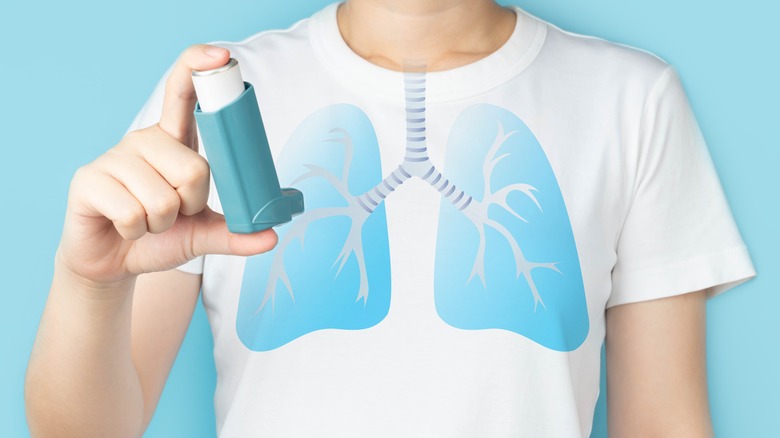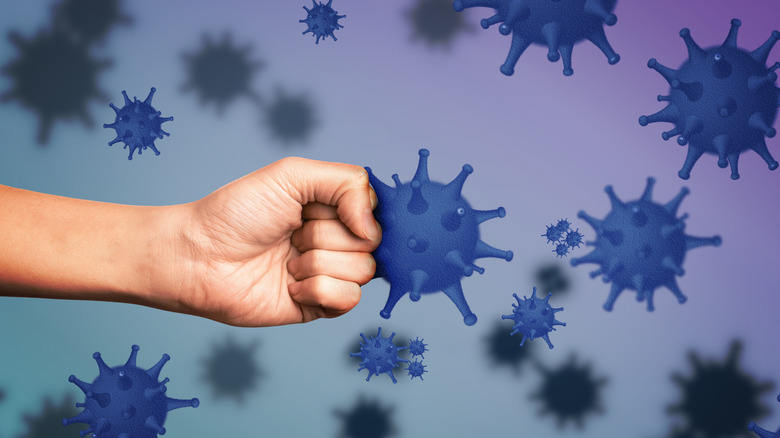What You Need To Know About Severe Asthma
Running out of air, feeling a tight — and sometimes painful — push in the chest, and having notable sharp sounds (wheezing) as you breathe, are common asthmatic symptoms that are difficult to live with (via Asthma + Lung UK). When these symptoms get worse with time, it may signal severe asthma. And although no detailed figures on severe asthma occurrence in most people with mild-to-moderate asthma exist, The Journal of Allergy and Clinical Immunology reckons it's about 10% of those with mild-to-moderate asthma who experience escalation to severe asthma — that's one in every 10 people.
The statistics also show there's a low death rate from severe asthma. Per the Asthma and Allergy Foundation of America, we lose about 11 people daily to asthma in the United States. The website also adds that if people with the condition get treated and are provided with good care and support, the deaths are evitable. Now, keeping in mind the mild-to-moderate asthma to severe asthma ratio, that's about one person lost to severe asthma daily. The number appears small but if you imagine it's a "breadwinner" who died, you can feel the deep impact.
Prevention of severe asthma (and deaths linked to it), begin with care, support, and treatment. And getting the right information about the condition in terms of diagnosis, best treatment methods, and support care tips is among the first prevention steps. Here's a guide that shares what you need to know about severe asthma so that you're well-armed.
It comes in different categories
According to the Journal of Allergy and Clinical Immunology, there are three main classifications of severe asthma: untreated severe asthma, difficult therapy-resistant severe asthma, and difficult-to-control severe asthma. Beginning with untreated severe asthma, this includes severe asthma that's left untreated for a long period (via Manipal Hospitals). A person with untreated severe asthma, for the most part, only seeks medical attention when they experience aggressive symptoms that often make their daily activities problematic. They normally don't go for proper treatment of the health condition. And the more it's left untreated, the more it affects other aspects of life such as sleep, level of productivity, and fitness levels.
Difficult therapy-resistant severe asthma, on the other hand, is a category that involves people with severe asthma that's not controlled properly (per Monaldi Archives Chest Disease). And even though the patients receive high inhaled steroid dosage, the symptoms keep becoming hard to deal with. This type can be further divided into three subtypes: fatal asthma (life-threatening asthma that quickly leads to death after suffering an asthma attack), brittle asthma (a rare type with a distinct feature of delayed flow of air out of the lungs), and chronic difficult asthma.
Lastly, difficult-to-treat asthma includes asthma that (even though medication can help manage it) gets out of control at times, as well as asthma that needs medication to make it less aggressive (via the Australian Journal of General Practice).
Subtypes and characteristics
The American Academy of Allergy Asthma & Immunology explains that years back, medical experts used to think asthma was similar for everyone and that one treatment approach for all cases would work effectively. However, through research and development in medical science, they discovered that different features and forms of inflammation for asthma exist. These varying notable features in asthma get labeled as phenotypes — the causes of different characteristics are called endotypes.
When it comes to severe asthma, some of the known phenotypes are aspirin-sensitive asthma (where asthma becomes severe after having aspirin), allergic asthma (a popular endotype where asthma gets worse after interaction with dust mite and pollen allergies), and exercise-induced asthma (where asthma symptoms worsen during or after physical exercise). More other phenotypes exist as asthma is a diverse health condition and these phenotypes get categorized based on their endotypes.
Clinical Reviews in Allergy & Immunology lists three types of endotypes (T2-High, T2-Low, and Non-T2) named after the T2 cytokines. The reason for using T2 cytokines to name them is because modern treatment targets these cytokines. In the T2-High endotype, there are phenotypes like late onset, atopic, and AERD — while in Non-T2, there are non-atopic, obesity-related, smokers, and elderly phenotypes.
Severe asthma attacks
There are times when your symptoms may worsen. In some instances, that may happen slowly with time, maybe a few hours, days, or weeks, while for some it may take minutes. The consistent, short, and sudden spikes in symptom severity are often called asthma attacks (per Better Health Channel). If these symptoms fail to improve even after receiving inhaled bronchodilators (treatment that broadens your airways and relaxes your lung muscles so that breathing becomes smoother) and other treatments, you're said to have status asthmaticus, according to Healthline. Here, you may experience severe asthma symptoms to extreme degrees. We're talking about only being able to say about two words after each breath, collapsing, lips becoming blue, and feeling tired and confused.
Better Health Channel also adds that if you experience this, or your friend does, you should seek to call for medical attention through 911 or any other emergency call service available. And as medical professionals prepare to head there, you should be administering first aid by using the general first aid rules or the action plan provided for you or the person you're helping, by the doctor.
The general first aid rules for severe asthma essentially involve three steps. Step one: Get your friend to sit while keeping their spine straight. Step two: Take their puffer, shake it and give them four puffs after taking deep breaths (if they don't have a spacer). Step three: Give them some time — preferably four minutes — and then give them four more puffs.
Causes of severe asthma
The same mild-to-moderate asthma causes bring about severe asthma. This means that interaction with tobacco smoke — as a smoker or non-smoker — can increase the possibility of a severe asthma attack. As a non-smoker, if you're around a person who's smoking, you can inhale the smoke and get affected by it. The same case applies to hanging around places with air emissions from vehicles or factories. Also, if you get allergic reactions from pets, especially the felines, you may want to be careful if you decide to keep them — the allergic reaction may contribute to you having severe asthma.
Pests like mice and roaches can also trigger the condition. However, as you aim to keep your house free of these pests, ensure you don't work with foggers and sprays as these chemicals may end up being counterproductive. Instead, consider trying other methods like bait traps (via the Centers for Disease Control and Prevention).
The American Lung Association has a thorough asthma causes list, which includes family history. If your parents and grandparents had it, chances are high you or your siblings may also get it. Researchers have also found that obesity is another contributor to the health problem. However, the reason and its effect on severe asthma haven't been accurately established (per Experimental Biology and Medicine).
How the diagnosis happens
According to Asthma + Lung UK, severe asthma diagnosis is often a complex process as it involves numerous considerations before your doctor can confirm you have the condition. Normally, it begins with an appointment with your doctor to determine if you've been working with the correct prescription. If yes, and your condition is still advancing, you may have severe asthma. Your doctor may advise you to speak with a severe asthma expert or clinical psychologist, allergist, specialist asthma nurse, pharmacist, physiotherapist, or physiologist depending on your medical history and dynamics of your health issue. There, the specialist will want to know how the problem interrupts your normal life and your loved ones, too. Afterward, you might do some tests.
Another article on Asthma + Lung UK says that some of the tests to expect include spirometry test (a test to see the amount of air you can exhale in a given period), gas transfer test (which determine oxygen levels going to your blood from the lungs), lung volume test (for determining your lung size), and bronchial challenge test (for challenging your airways on purpose). Your specialist may also recommend the Asthma Control Questionnaire, the RCP 3 Questions, or the Asthma Control Test to know about your symptoms and how well you're regulating them. Moreover, the diagnosis may also include blood tests, CT (computerized tomography) scans, chest x-rays, sputum induction tests, nasal endoscopy, and fractional exhaled nitric oxide (FeNO) tests.
Assessments and their tools
The assessment of severe asthma is usually done by a group of medical experts who collaborate to determine and come up with ways to successfully manage the illness uniquely for every patient. The assessment is beneficial as it helps to appreciate the diverse nature of severe asthma that new research finds useful in understanding the pattern of the condition — and, of course, finding accurate solutions. Remember, several types of severe asthma exist, so keeping this in mind during assessment will provide more effective results than using the outdated one-size-fits-all management approach.
Three main steps are crucial when assessing. The first step is the diagnosis that helps make confirmation that the problem you have is actually severe asthma. The possibility of you, the patient, having two health issues at once is also tested. The third step involves evaluating the phenotypes of the asthmatic condition (via Taylor & Francis Online).
The Journal of Asthma Allergy also insists on the importance of keeping in mind lung function and inflammatory biomarkers in the assessment, and treatment plan optimization. It also lists some common tools used in severe asthma assessment which include the dose counter (for keeping count of inhaler doses), canister weighing (for determining dose quantity in a pressurized metered dose inhaler), prescription records, serum prednisolone or cortisol (for assessing cortisol or prednisolone) and electronic inhaler monitoring (for evaluation and record-making of how well you follow instructions on inhaled therapies).
Medical treatment for severe asthma
For severe asthma treatment, there are many directions you can take. Starting with medication, several options are at your disposal. Beta-agonists (short-acting) are one of the fastest medications recommended when you have severe asthma attacks. These medications include albuterol (per the Mayo Clinic). The American Academy of Family Physicians also adds ipratropium and levalbuterol to this category. Children as young as two, teenagers, and adults can benefit from them at varying doses. A machine that converts these medications into a fine mist that makes effective inhalation of the medications into your lungs (called a nebulizer) is a necessity. The second category is corticosteroids such as mometasone, beclomethasone, flunisolide, budesonide, and fluticasone. These medications help to decrease inflammation and manage other symptoms of your condition.
The third category is leukotriene modifiers, which come in two types: leukotriene receptor antagonists that include medication like zafirlukast and montelukast and leukotriene inhibitors like zileuton. Both types help with inflammation but via different mechanisms. Leukotriene inhibitors inhibit the manufacture of 5-lipoxygenase while leukotriene receptor antagonists stand in the way of leukotriene receptors. When these three categories of treatment fail, your doctor may recommend biologics. Per the definition given by the American Academy of Allergy Asthma & Immunology, biologics are pretty much altered medications that come from living organisms' cells like bacteria that aim for particular human molecules (in this case, antibodies). Examples of biologics are mepolizumab, dupilumab, benralizumab, and reslizumab.
FDA-approved top-up treatment for all types of severe asthma
The U.S. Food & Drug Administration now recommends tezspire injection as more of a booster treatment for severe asthma. It's shown to work on all forms of severe asthma through several clinical trials where it brought down a higher number of asthma attacks and emergency cases in participants than placebo. And the best part is that children from 12 years upward and adults can take it without any problems. Its recommended use is working with it alongside the medications such as corticosteroids you're currently taking.
Tezspire's mechanism of action works around the molecule known for airway inflammation called thymic stromal lymphopoietin. Tezspire comes with an active element known as tezepelumab-ekko, a monoclonal antibody (which is a biologic) that helps deal with the molecule. Tezepelumab-ekko is actually a biologic (via Medical News Today). The FDA is keen on noting that you should only receive tezspire through a medical expert once per month through an injection below your skin.
Some cautions given for the treatment are ensuring you avoid live vaccines and getting helminth infection treatment beforehand if tezspire will be part of your treatment. If your doctor recommends cutting down on your corticosteroids as you get tezspire, you should also make sure that you are under the careful watch of the doctor as you do this to ensure you take the best approach and optimize your treatment.
Common therapies for severe asthma
Allergen-specific immunotherapy is a form of therapy that can help enhance lung sensitivity, minimize medication consumption and bring down severe asthma (via Cochrane). It works through desensitization — where you receive allergen injections below your skin. Allergens are substances that pave the way for allergic reactions in someone who gets affected by allergies. This type of immunotherapy is commonly referred to as SCIT (subcutaneous immunotherapy) and the World Journal of Clinical Cases explains that it's less safer than another type of allergen-specific immunotherapy known as sublingual immunotherapy, which doesn't involve injections.
Considering it uses allergens, there's always a possibility of side effects like rashes, lumps at places you get the injection, running out of air, and wheezing. It may also be as dangerous as experiencing a catastrophic allergic reaction, although that happens on rare occasions (via Cochrane). Another helpful therapy is the optimized inhaled therapy which focuses on optimizing your inhalation techniques and ensuring you follow the recommended inhalation process as instructed. This therapy helps to reduce the chances of using the wrong techniques and inhalation processes that often lead to uncontrolled asthma.
Experts encourage patients to be actively involved in the therapy by choosing the inhaler, whether it's the metered dose inhaler or dry powder, and also in testing the inhaler as that helps make the therapy more effective. Other therapies available include therapy for comorbidities, and anti-IgE therapy (per Deutsches Ärzteblatt International).
Natural treatments
Like tezspire, natural remedies and complementary techniques can help deal with severe asthma symptoms and make your life less stressful when used together with medication. Some of the natural methods include the Buteyko breathing method, yoga, and mindfulness (via Healthline).
The Buteyko breathing method is a form of breathing that helps you breathe through your nose slowly and gradually. It can help you catch respiratory infections less often and prevent you from having dry and sensitive airways that come with breathing through your mouth. According to American Journal of Nursing Research, Buteyko breathing can boost your daily asthma control and peak expiratory flow rate, along with improving asthma severity. Yoga is another breathing and pose-based practice that helps to improve overall well-being. When it comes to severe asthma, yoga practices like Sahaja yoga may provide stress relief and improve moods, although in the short term (per Thorax).
Also, mindfulness is a reliable option for breath control. The practice involves increasing awareness of your breath, thoughts, sensations, and emotions. It can help you let go of stress and other negative emotions you may feel at times which also make asthma worse (via Mindful). On its own, mindfulness can help improve your breathing as well as when used alongside yoga. Both can make the quality of your life better health-wise (per BioMed Central).
Lifestyle changes can also improve the condition
Making a few tweaks to your lifestyle can also bring a massive difference in asthma severity. Breathe (Sheffield) explains that people with asthma should consider taking on fitness exercises as it boosts your overall health and also enhances lung function. And changing from less to more nutrient-rich foods can go a long way. You should aim to cut down on saturated fats and have more whole grains, vegetables, and fruits — this alone can decrease the risk of worsening asthma, and can also ease airway inflammation, and give you better control of the condition. People with both asthma and obesity should try losing weight, because it can help elevate their quality of life (in terms of having asthma) and also make it more controllable.
Sage Journals also recommends educating people with asthma on how to choose and work with better food choices and physical exercises like resistance training and aerobic exercises. These lifestyle choices helps motivate people to take proper courses of action that will improve their health. Also, counseling sessions combined with weight loss programs bring more effective results than just theory.
According to Case Management Body of Knowledge, other lifestyle modifications that will further help make severe asthma more tolerable include quitting smoking and keeping away from secondhand smoke, covering your nose with a scarf when you're in cold environments, having air conditioners in your house to control airborne pollen levels, and replacing your carpet with hardwood flooring.
Prevention, recovery, and management
You may have heard that Azithromycin could be a good prevention intervention for severe asthma and you could be considering it. However, a study published in Thorax showed it may not decrease the severity of asthma, and neither can it neutralize lower respiratory tract infections.
Instead, focus on taking your medication as your doctor instructed. Even if you suffered an attack and got taken to the hospital and the doctors helped you recover, afterward, your doctor will still advise you to follow your asthma action plan which is largely about taking your medication the right way. WebMD also mentions that washing your hands regulalry will keep cold and other viral infections away. Also, if your doctor schedules several appointments with you to discuss and manage your health, make sure you show up for all of them as each contributes to your recovery and overall control of the condition.













